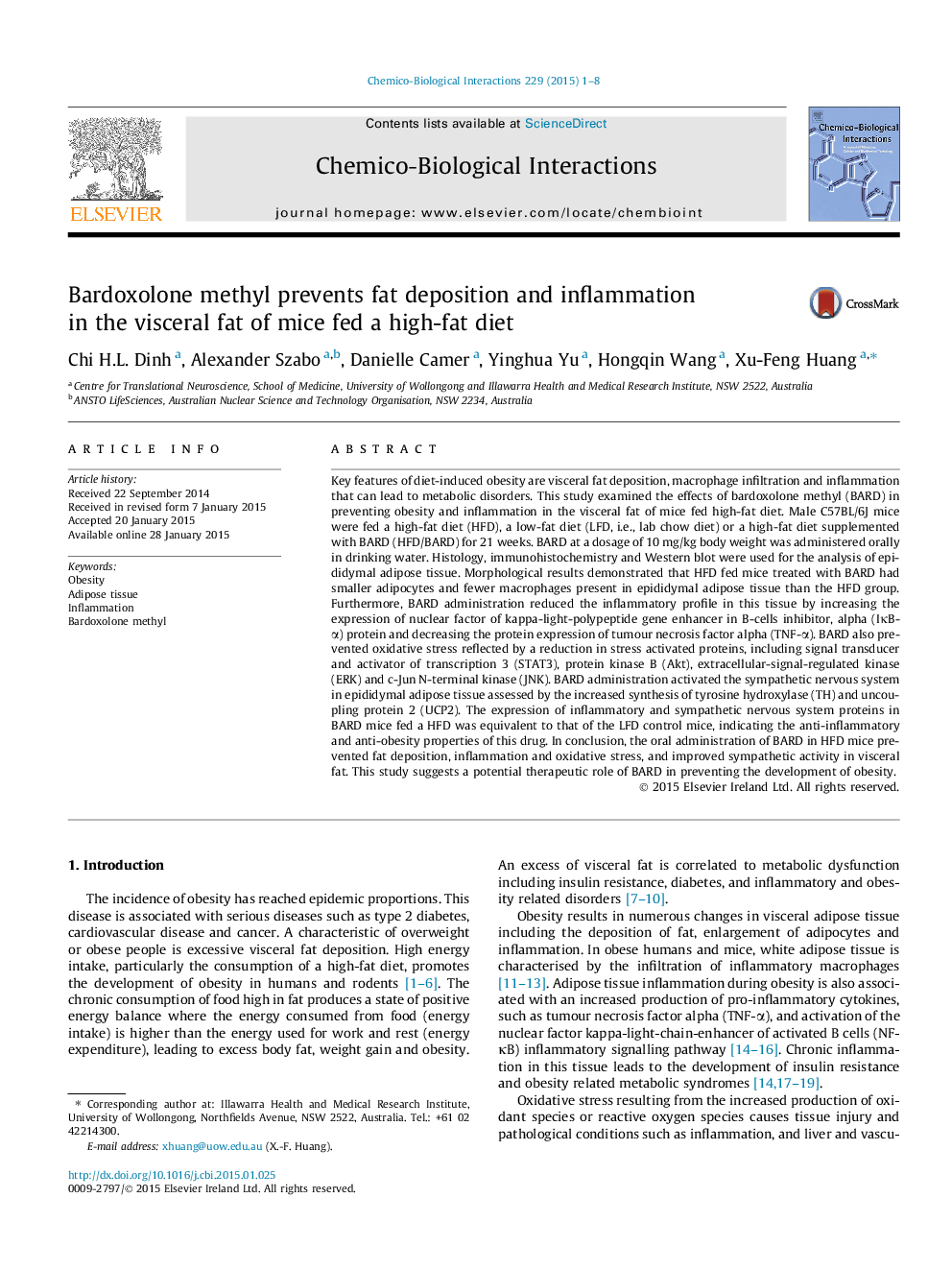| کد مقاله | کد نشریه | سال انتشار | مقاله انگلیسی | نسخه تمام متن |
|---|---|---|---|---|
| 5847912 | 1561612 | 2015 | 8 صفحه PDF | دانلود رایگان |
عنوان انگلیسی مقاله ISI
Bardoxolone methyl prevents fat deposition and inflammation in the visceral fat of mice fed a high-fat diet
ترجمه فارسی عنوان
باردوکسولون متیل جلوگیری از رسوب چربی و التهاب در چربی احشایی موشهای تغذیه شده با رژیم غذایی با چربی بالا
دانلود مقاله + سفارش ترجمه
دانلود مقاله ISI انگلیسی
رایگان برای ایرانیان
کلمات کلیدی
چاقی، بافت چربی، التهاب بارتزولون متیل،
موضوعات مرتبط
علوم زیستی و بیوفناوری
علوم محیط زیست
بهداشت، سم شناسی و جهش زایی
چکیده انگلیسی
Key features of diet-induced obesity are visceral fat deposition, macrophage infiltration and inflammation that can lead to metabolic disorders. This study examined the effects of bardoxolone methyl (BARD) in preventing obesity and inflammation in the visceral fat of mice fed high-fat diet. Male C57BL/6J mice were fed a high-fat diet (HFD), a low-fat diet (LFD, i.e., lab chow diet) or a high-fat diet supplemented with BARD (HFD/BARD) for 21 weeks. BARD at a dosage of 10 mg/kg body weight was administered orally in drinking water. Histology, immunohistochemistry and Western blot were used for the analysis of epididymal adipose tissue. Morphological results demonstrated that HFD fed mice treated with BARD had smaller adipocytes and fewer macrophages present in epididymal adipose tissue than the HFD group. Furthermore, BARD administration reduced the inflammatory profile in this tissue by increasing the expression of nuclear factor of kappa-light-polypeptide gene enhancer in B-cells inhibitor, alpha (IκB-α) protein and decreasing the protein expression of tumour necrosis factor alpha (TNF-α). BARD also prevented oxidative stress reflected by a reduction in stress activated proteins, including signal transducer and activator of transcription 3 (STAT3), protein kinase B (Akt), extracellular-signal-regulated kinase (ERK) and c-Jun N-terminal kinase (JNK). BARD administration activated the sympathetic nervous system in epididymal adipose tissue assessed by the increased synthesis of tyrosine hydroxylase (TH) and uncoupling protein 2 (UCP2). The expression of inflammatory and sympathetic nervous system proteins in BARD mice fed a HFD was equivalent to that of the LFD control mice, indicating the anti-inflammatory and anti-obesity properties of this drug. In conclusion, the oral administration of BARD in HFD mice prevented fat deposition, inflammation and oxidative stress, and improved sympathetic activity in visceral fat. This study suggests a potential therapeutic role of BARD in preventing the development of obesity.
ناشر
Database: Elsevier - ScienceDirect (ساینس دایرکت)
Journal: Chemico-Biological Interactions - Volume 229, 5 March 2015, Pages 1-8
Journal: Chemico-Biological Interactions - Volume 229, 5 March 2015, Pages 1-8
نویسندگان
Chi H.L. Dinh, Alexander Szabo, Danielle Camer, Yinghua Yu, Hongqin Wang, Xu-Feng Huang,
